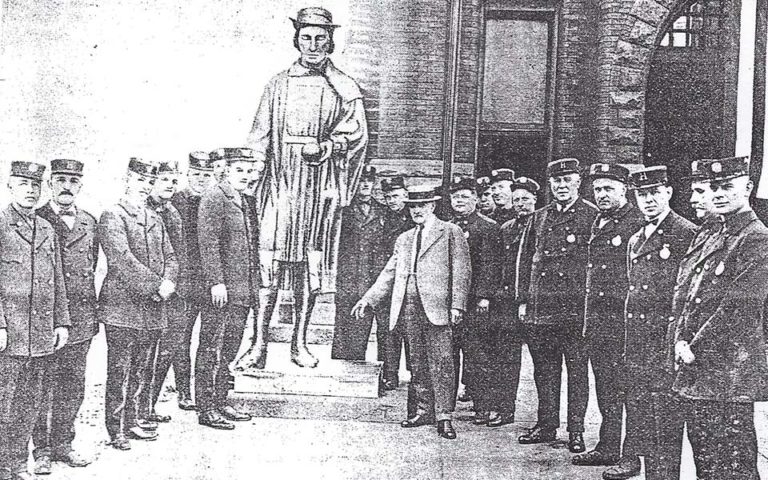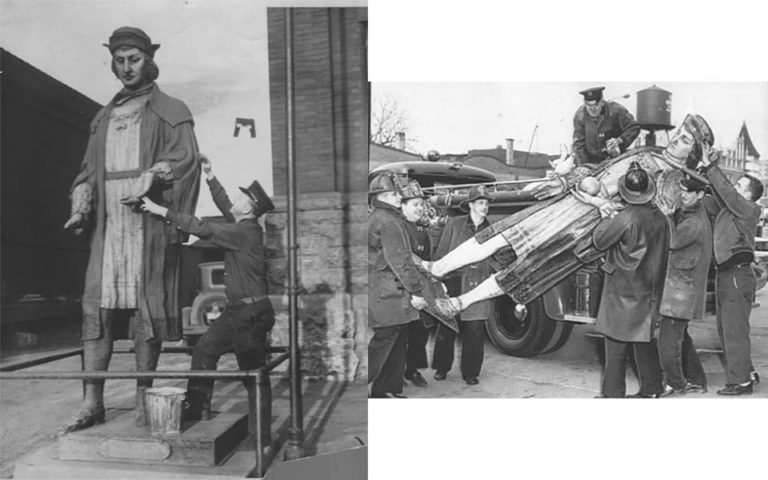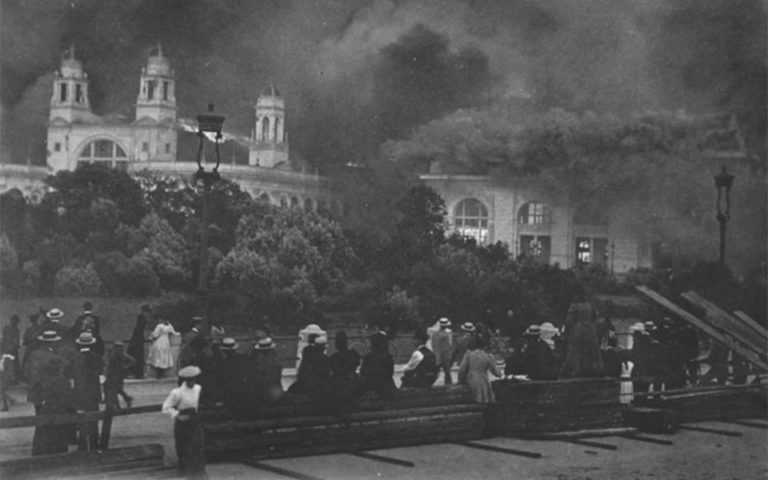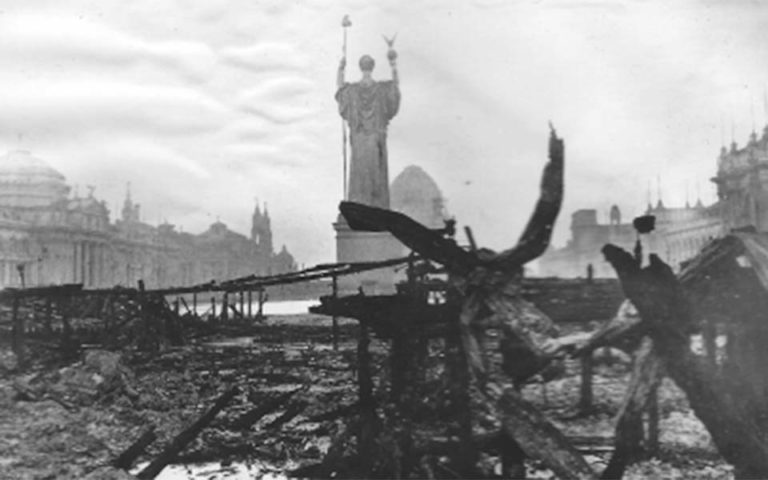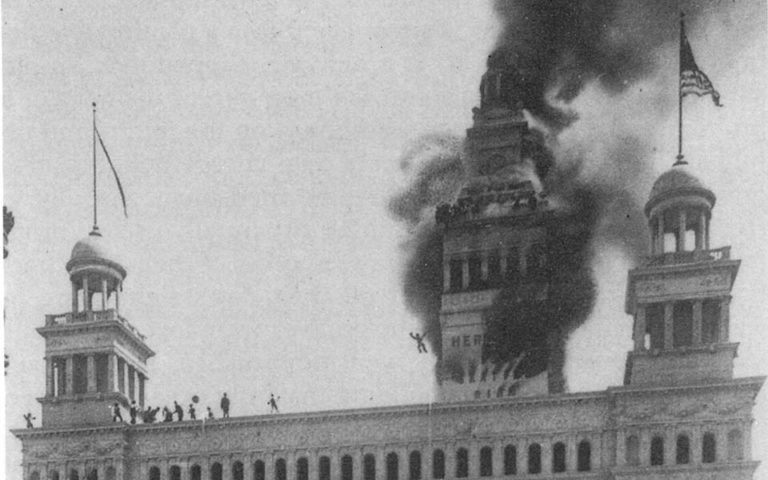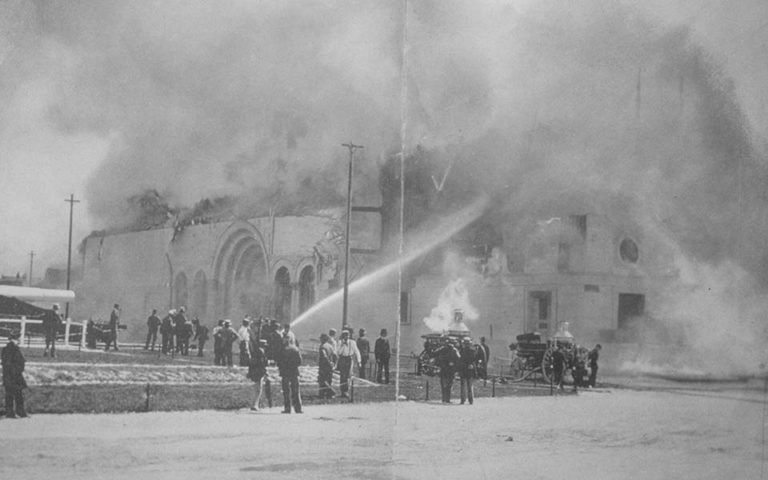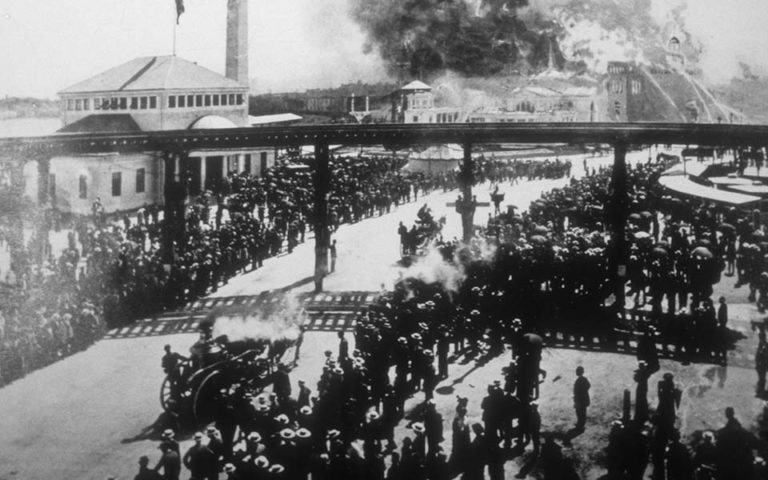Incident Date:
July 10, 1893
Department:
Chicago and World’s Fair Fire Departments (IL)
Number of Line-of-Duty Deaths:
13
Photos Courtesy of the Chicago Fire Department Gold Badge Society and the Fire Museum of Greater Chicago
One of the deadliest fires in Chicago’s history erupted in the Cold Storage Building at the World’s Fair on July 10, 1893. The estimated 50,000 bystanders’ cheers for firefighters would soon fall silent as they watched the conflagration spread to the nearby buildings and kill thirteen firefighters and four civilians.
Having opened to the public in May 1893, the World Fair: Columbian Exposition celebrated the 400th anniversary of Columbus’s voyage to North America. The Chicago exposition not only influenced culture and society but also would shape American architecture and the arts. Constructed along Lake Michigan in Jackson Park, the exposition included two hundred buildings that housed exhibitions from over sixty countries along with the world’s very first Ferris wheel.
The World’s Columbian Exposition’s neoclassical architecture focused on symmetry, balance, and splendor. Buildings were covered with an artificial white stone known as staff, which looked like carved marble—thus giving it the nickname, the “White City.” Staff is a mixture of powdered gypsum or Plaster of Paris with cement, glycerin, dextrin, and water. This malleable building material is cast in a mold, making it ideal for the ornamental temporary fair structures.
- The largest marvel at the fair, the Cold Storage Building, was known as the “Greatest Refrigerator on Earth.” This five-story building included a warehouse for food storage and an ice-skating rink on the top floor for fair patrons.
- To operate these refrigeration units, a 200-foot iron chimney was installed on its roof. Focused on the aesthetics of the structure, builders masked the unsightly smokestack with a wooden tower. A cupola finished off the central tower, its base resting just thirty inches above the rim of the chimney flue—creating what would come to be a deadly fire hazard.
- Because of a few smaller fires in June 1893, firefighters had discovered that there was no access from the roof to the top of the chimney where the fires were originating. At the time, the acting chief of the World’s Fair Fire Department stated, “That building…is a miserable firetrap and will go up in smoke before long.”
After 1:00 pm on July 10, a small fire and heavy smoke from the cupola were spotted at the top of the flue stack, bringing approximately twenty World’s Fair and nearby Chicago firefighters to the scene. Firefighters ascended the stairs from the ice rink and quickly constructed their footholds up the tower. Firefighters then hoisted hose lines up with ropes to a narrow gallery just below the top of the central tower, tying them off to the balcony. Just after they reached the summit, flames broke out fifty feet below them, cutting off their escape. They had not noticed that the debris from the burning cupola was falling into the void space between the wooden walls of the tower and the smokestack, beyond the fire-brick that only went 70-feet up the tower.
Faced with the split-second choice of jumping sixty feet or sliding down ropes and hose lines—which could burn through at any moment—some firefighters narrowly escaped. Other firefighters and civilian workers were trapped or hit with falling debris as the tower collapsed into the building.
According to a Chicago Tribune account, Captain James Fitzpatrick and one other firefighter were the last on the top of the stack. Fitzpatrick offered his firefighter the last partially burned rope to escape, but he refused. The captain then grabbed the rope and used it to swing clear of the flames but was injured in the fall; he later died of his injuries at the hospital. His companion tried a similar escape just as the tower fell but was caught in the collapse.
- Twenty-one Chicago and five World’s Fair Exposition engine companies would respond to keep the fire from spreading any further.
- Seventeen lives were lost that afternoon, including thirteen firefighters from the World’s Fair and Chicago Fire Departments.
This fire was the deadliest fire for the Chicago Fire Department until the 1910 Chicago Union Stockyards Fire, which claimed the lives of twenty-three firefighters.
The statue of Christopher Columbus that topped the Cold Storage Building was presented to the Chicago Fire Department at the close of the exposition. It stood reverently at Chicago Engine 51 on Wentworth Avenue in memory of those who died fighting the Cold Storage Building fire. In 1924, the statue was refurbished and rededicated during the July 4th celebration.
When Engine 51 closed, the statue was again redecorated and was placed on display at City Hall Greater Chicago and at the 9-1-1 Center. It now has a permanent home in the Fire Museum of Greater Chicago.


